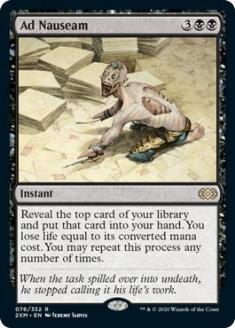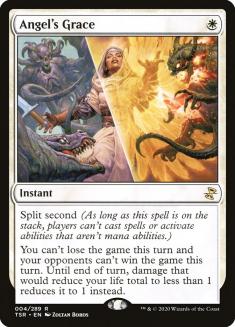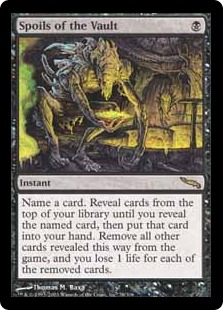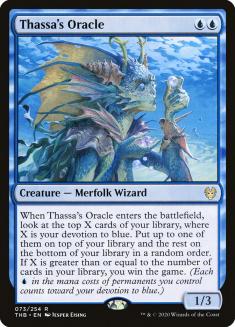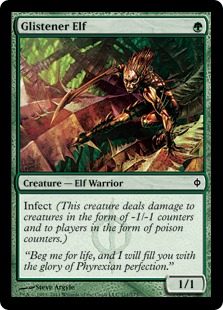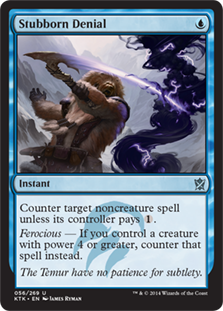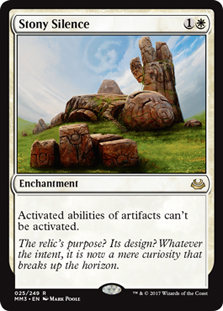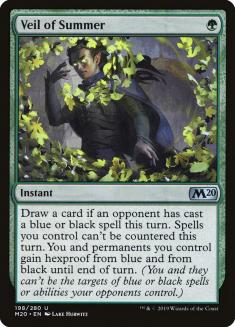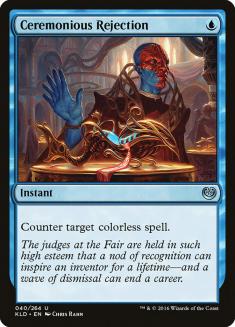In a format like Modern that has an incredible diversity of archetypes, it’s easy for us to fall into our first conception of a deck and move on, never to consider playing it again. But all of those fringe archetypes are knocking on the door of high level competitive viability, and often a new card or two is enough to elevate into the metagame’s top tier. I believe that Thassa’s Oracle has done that for Ad Nauseam, and though the deck has started putting up some solid results, it has yet to earn the appropriate recognition from the player base.
Ad Nauseam as a deck has been around for years, but has never been more than a bit player that occasionally shows up when the metagame is favorable for it. I saw it in the early days of Izzet Phoenix’s emergence in Modern as a foil for the new bogeyman. But the deck has never been more than a flash in the pan, because it wasn’t powerful enough to compete in all but the most favorable metagames.
But Thassa’s Oracle has gone a long way towards shoring up the deck’s weaknesses, and now I think it’s up to the task of being a consistent player in Modern. I evaluate combo decks by three criteria: speed, resilience, and consistency. Thassa’s Oracle improves the deck on all these axes.
Speed
Previously, Ad Nauseam was almost strictly a Turn 4 kill combo deck, which put it behind decks like Gifts Storm or Devoted Devastation, though not by much. This speed was largely determined by the deck’s reliance on Ad Nauseam, a five-mana spell. You often needed to wait until a Lotus Bloom came off suspend, or until you could untap with a Phyrexian Unlife to resolve Ad Nauseam and win the game. It’s possible to cast Angel’s Grace and Ad Nauseam on Turn 3 with the aid of a Pentad Prism and Simian Spirit Guide, but that’s a lot of cards to find.
With Thassa’s Oracle, you have an additional Turn 3 kill utilizing Angel’s Grace followed by Spoils of the Vault naming a card that’s not in your deck to exile your library. This kill only requires four mana, so a Pentad Prism will suffice even without a third land drop. Unfortunately, red mana doesn’t help cast any of these spells so Simian Spirit Guide won’t suffice unless you’re filtering it through a Pentad Prism on that turn, but you can’t have everything.
It’s still mostly a Turn 4 combo, but the additional Turn 3 kill is helpful, and puts it much more in line with the speed of combo decks in the metagame. Gifts Storm can kill Turn 3 but often kills Turn 4. Creature combo decks are generally the fastest, but they are more vulnerable to creature removal as a result. Ad Nauseam completely blanks that removal, especially now that it doesn’t have to use Laboratory Maniac as a win condition anymore.
Oops All Spells similarly kills around Turns 3 or 4, but is vulnerable to graveyard hate. When it comes to the desired speed for Ad Nauseam, I think the best comparison is Ironworks, which was good enough to merit a ban. That deck was more Turn 4 than Turn 3 as well, so at this point I think Ad Nauseam is in good company.
Resilience
As I noted above, Ad Nauseam completely blanks creature removal, and the addition of Thassa’s Oracle doesn’t hurt you there since Spoils of the Vault exiles your entire library. That way you don’t need the Oracle to stick around for the trigger to resolve, unlike Laboratory Maniac. So the deck gains slightly here.
But the bigger gain is no longer having to rely entirely on Ad Nauseam. An early Thoughtseize is devastating when you know you’d have to find another copy in order to win, whereas your other combo pieces come with more redundant copies to find. With the Spoils-Oracle kill, you have many other permutations that can come together to form a kill, making it much easier to recover from early discard.
Even worse than discard, relying so heavily on Ad Nauseam made you highly vulnerable to cards like Meddling Mage. Not only can it completely shut down your deck, it made the deck easy to play against.
When you’re playing against Gifts Storm for example, it’s often difficult to determine how best to disrupt them. Their draw can play out in many different ways, and if you go to cut off their mana or their graveyard when it’s not integral to their plan, you’re not going to win. The way to cut off Ad Nauseam was always very clear: stop them from resolving the card. You could do it with discard, counterspells, or cutting off their mana depending on what you were best equipped to do, but your goal in the matchup was always obvious.
Now that the deck can win without Ad Nauseam, playing against it is so much trickier. It’s still among your most important cards, but your opponents will have to figure that out rather than assuming it from the start. The doubt that comes with that leads to mistakes which leads to more wins.
Consistency
I sense a theme here, because once again it’s the decreased reliance on Ad Nauseam that was problematic here. Temples and Serum Visions can only do so much, because sometimes you just don’t find the card in a reasonable time frame. That’s the nature of variance in Magic.
In a randomized 60-card deck, there’s an 18.7% chance that there are zero copies of Ad Nauseam in the top twenty cards. And a 5.6% chance it’s not in the top 30 cards. That means these situations, in which it’s very difficult to win, are likely to occur multiple times in every major tournament you play.
You could mitigate this problem by aggressively mulliganing, but 60% of your seven-card hands won’t have an Ad Nauseam, so you can’t possibly mulligan all of them.
But Thassa’s Oracle has gone a long way towards shoring up the deck’s weaknesses, and now I think it’s up to the task of being a consistent player in Modern.
Of course Spoils of the Vault can act as additional copies of Ad Nauseam, but if you have Angel’s Grace, then you either need seven mana to assemble a kill all in one turn or you’re taking a huge risk.
Having additional paths to victory means a much higher portion of your draws lead to a kill, which not only makes your draws more consistent, it also means you can keep a wider range of hands with confidence that you can find what you’re missing.
At this point, Ad Nauseam is built to maximize Spoils of the Vault, which is the most powerful card in the deck when properly enabled. A one-mana tutor is already great, but here it can also function as a combo piece with Thassa’s Oracle. It’s that additional functionality that’s critical, and was missing from the deck in years past. Now the deck’s engine is fully supported.
Positive Metagame Development
In addition to the deck itself significantly improving, the Modern metagame has shifted in recent years in ways that make it better positioned. In this case, it’s the decline in three cards that used to me metagame staples that have helped Ad Nauseam’s positioning:
Infect is Ad Nauseam’s worst matchup. You don’t interact with their creatures well, so the matchup is mostly a race. They are significantly faster, and your Angel’s Graces and Phyrexian Unlifes that typically buy multiple turns against aggro decks are useless against poison counters. And lastly they often have counterspells in their sideboard for additional disruption.
The matchup is a complete nightmare. Fortunately, the deck hasn’t been popular since the rise of Izzet Phoenix and its maindeck Gut Shots, and even with that deck’s decline, the recent additions of Wrenn and Six, Lava Dart, and other effective tools have kept the deck in check. I don’t see Infect returning to prominence any time soon, so you don’t have to live in fear of Glistener Elf.
The evergreen plan to beat combo decks is to combine pressure with disruption. Grixis Death’s Shadow was perhaps the best ever at this, with its efficient creatures, discard, and this pesky counterspell that often sealed up the game when you were forced to go for a combo or take lethal damage.
The Deaths’ Shadow decks these days are built with more cheap creatures and removal so they can play more of a midrange game. That strategy is poorly equipped against combo like Ad Nauseam, and the cheap creatures don’t change their clock by much in the face of Phyrexian Unlife and Angel’s Grace.
Cutting themselves off from an entire angle of attack makes it much easier to sideboard and play, since you never have to worry about your combo working once you assemble the necessary pieces.
Once one of the most popular sideboard cards in the format, Stony Silence hasn’t seen much play since Mox Opal was banned. And for a deck that wants to accelerate with Pentad Prism and Lotus Bloom, that’s good news. Your artifact mana is so important because your land count is rather low, and Stony was a ubiquitous card that often slowed you down by two or more turns. That’s an eternity in Modern, whether for an aggro deck looking to end the game outright, or a control deck that wants to set up a wall of counterspells.
Without Stony Silence in the metagame, you’re able to play at an accelerated pace much more often, and you only have to worry about your double Lotus Bloom hands getting blown apart by that pesky Karn, the Great Creator.
Here’s the list I would register:
Creatures (7)
Lands (20)
Spells (33)

Lists of the deck don’t vary much, since the cards you need are highly specialized. Still, I’ve never liked how many fast lands this deck plays, since along with the Temples, it leads to a lot of your later land drops entering tapped. In games where you don’t have access to your artifact mana, you’re often drawing to the last mana you need, and every turn matters. With Veil of Summer, you’re playing more of the five-color lands to enable the splash, so you don’t need as many full two-color lands. So I’m in favor of playing a few copies of Clearwater Pathway over Darkslick Shores.
In the sideboard, I like having more copies of Veil of Summer, since the card is busted in half. Seriously, I have to hear Corey Baumeister sing its praises nearly every day on VS Live! and I’ve witnessed it enough at this point that I’m always erring toward three or four copies in a deck that wants it.
Lastly, I’m also high on Ceremonious Rejection. Chalice of the Void and Karn, the Great Creator are problematic cards, and Rejection is the best answer for them. Right now the single copy supplements Thoughtseizes, but in a metagame where Eldrazi Tron is big, I would move the split more in favor of the counterspell.
Tips and Tricks
- In most decks you want to cast Serum Visions on Turn 1 instead of Sleight of Hand. In this one you often play the Sleight first because of the payoff of finding Lotus Bloom
- Angel’s Grace can be used to stop a Pact trigger if you absolutely have to use one to stay alive
- The Ad Nauseam/Lightning Storm kill can be executed on your opponent’s turn if you need to play around an alternate cast Force of Negation
- To determine how risky to be with Spoils of the Vault, consider how much pressure you’re under to end the game. The less time you have, the bolder you have to be
- Against Thalia, Guardian of Thraben or a similar tax effect, you can pay additional colors of mana for Pentad Prism and get more counters on it to use later
- Against soft counters, it’s often best to lead with Veil of Summer, since you only commit one mana on your initial play, forcing them to either use two counterspells on it or let it resolve after you pay for the first. Even if you don’t have enough mana left to combo, you’re still up cards and have all your combo pieces.
Ad Nauseam is just starting to pick up, putting up multiple high finishes on Magic Online last weekend, but it still doesn’t have that marquee finish that makes the rest of the metagame take notice. But you won’t have much more time to take advantage of unprepared lists and players. After years of living in mediocrity, Ad Nauseam is ready to compete with the format’s best.


